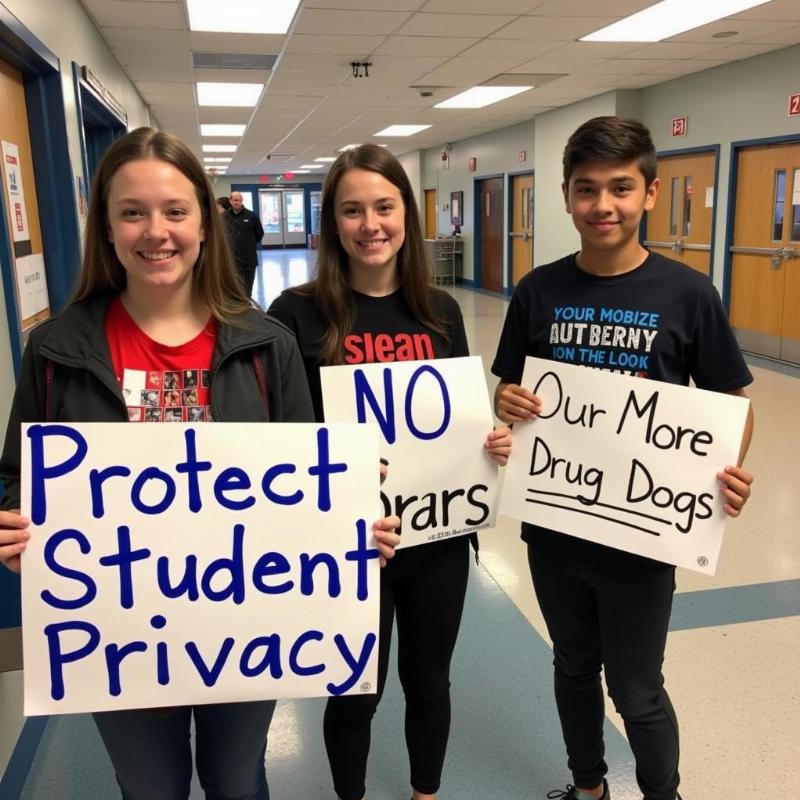Drug sniffing dogs in schools have become a common practice in the United States, sparking ongoing debate about their effectiveness, legality, and impact on the school environment. While proponents argue that these K9 units deter drug use and create a safer learning environment, critics raise concerns about student privacy, potential racial bias, and the overall effectiveness of this approach. Understanding the complexities surrounding this issue is crucial for parents, students, and educators alike.
The Role of Drug Sniffing Dogs in School Safety
The primary goal of using drug sniffing dogs in schools is to deter drug possession and use among students. The presence of a K9 unit can send a message that drug use will not be tolerated, potentially discouraging students from bringing illegal substances onto school grounds. This proactive approach is seen by many as a vital tool in maintaining school safety and fostering a drug-free learning environment. However, the actual impact of drug dogs on student drug use rates remains a subject of debate.
Some studies suggest that drug dogs are not as effective as intended, with some even suggesting they may lead to an increase in drug use outside of school. Additionally, the presence of drug dogs can create a climate of fear and distrust within the school community. This can negatively impact the relationship between students and administrators, hindering the development of a positive and supportive school culture.
Legal Considerations and Student Rights
The use of drug sniffing dogs in schools is governed by the Fourth Amendment of the U.S. Constitution, which protects individuals from unreasonable searches and seizures. The Supreme Court has ruled that while school officials do not need a warrant to search students, they must have “reasonable suspicion” that a search will reveal evidence of wrongdoing. This legal standard is lower than “probable cause” required for searches outside of school. However, the presence of drug dogs can complicate this issue, as their use has been challenged on the grounds of creating an overly intrusive environment.
 Students protesting drug dogs in schools
Students protesting drug dogs in schools
“The legal landscape surrounding drug dogs in schools is complex and constantly evolving,” says John Smith, a prominent education lawyer in California. “It’s crucial for school districts to have clear policies in place that comply with both federal and state laws to protect student rights while maintaining a safe learning environment.”
Alternatives to Drug Sniffing Dogs
Several alternatives to drug sniffing dogs are being explored by schools across the country. These include:
- Increased counseling and support services for students struggling with substance abuse.
- Implementing evidence-based drug prevention programs.
- Strengthening partnerships with local law enforcement and community organizations.
- Focusing on creating a positive school climate that promotes healthy choices.
These methods prioritize a more holistic approach to drug prevention, focusing on education, support, and building a positive school community rather than relying solely on punitive measures.
Conclusion
The debate surrounding drug sniffing dogs in schools is complex and multifaceted. While the intention of enhancing school safety is laudable, the potential negative consequences on student privacy and school climate must be carefully considered. Exploring and implementing alternative strategies that prioritize education, support, and a positive school environment may offer more effective and equitable solutions to addressing drug use among students. A comprehensive approach that balances safety concerns with student rights is crucial to fostering a healthy and productive learning environment for all.
FAQ
- Are drug sniffing dogs allowed in schools? Yes, but their use is subject to legal restrictions and guidelines regarding reasonable suspicion.
- What are the potential downsides of using drug dogs in schools? Potential downsides include violations of student privacy, creation of a climate of fear, and questionable effectiveness in deterring drug use.
- What are some alternatives to drug dogs? Alternatives include increased counseling services, drug prevention programs, and community partnerships.
- Do drug dogs actually deter drug use in schools? Studies on the effectiveness of drug dogs are mixed, with some suggesting they may not be as effective as intended.
- Can drug dogs search student lockers without a warrant? School officials generally need reasonable suspicion, not a warrant, to search lockers, but the use of drug dogs can complicate the issue.
- How can schools balance safety and student rights when it comes to drug prevention? Schools can achieve this balance by implementing comprehensive strategies that address both safety concerns and student privacy rights.
- What role can parents play in addressing drug use among students? Parents can engage in open communication with their children about the dangers of drug use and support school initiatives that promote healthy choices.
Beautdogs.us: Your Trusted Source for Dog Care Information
Beautdogs.us is a leading dog lifestyle website in the US, dedicated to providing comprehensive and reliable information on dog care, breed specifics, and products. We cater to both new and experienced dog owners, offering expert advice on everything from nutrition and training to health and wellness. Our team of Certified Pet Professionals and Content Strategists ensures that our content is accurate, engaging, and aligned with American Kennel Club guidelines and breed standards. For expert guidance on all aspects of dog ownership, connect with us today! Email: [email protected], Phone: +1 501-555-7529.